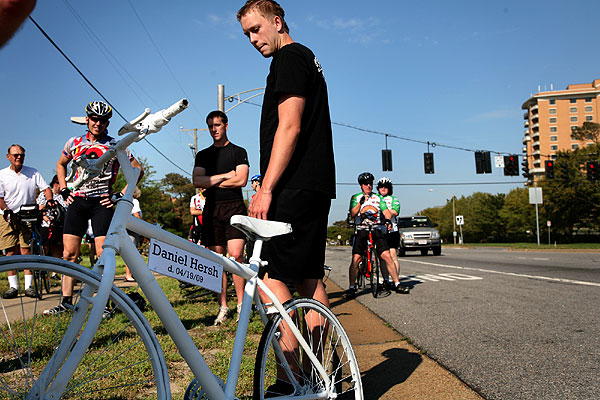 |
| He rides the line. |
"Stay behind me now, guy. Follow the leader."
With that said, I lead my four year old to preschool on his own two wheeler. To our right is a line of parked cars. Behind us is a school crossing. Passing us on our left is a panel truck. Coming up is our left turn. We share the road with moving cars, parked cars, idling school buses, minivans, dump trucks, geese and ducks, children, joggers, dogs and taxis. It's a little over a kilometer (half a mile) from our house to his preschool. There are no hills- just a flat, neighborhood grid dominated by a couple schools, apartment blocks and churches. A nearby, parallel arterial street is six lanes wide. Our daily route to school takes us down a two lane road punctuated by 4-way stop signs.
 |
| Yield to wildlife. |
At the age of two, Kelvin first went to school in the back of a baby trailer, or strapped to a tandem stoker seat. By his third birthday Kelvin was insisting on riding his little kick bikes to school. Even though his legs would be tired before we were even halfway there, he still wanted to ride his own bike. We started riding on the sidewalk. Kelvin was pretty fast on a sturdy, pink tricycle he inherited from his sister. And while his trike was faster than his kick bikes, Kelvin still wanted to be on his two wheelers.
 |
| Kelvin popping a wheelie on the way home from preschool. |
The rule in our house for our own kids and neighborhood kids is that if they're riding wheels, they need a helmet on their head. The condition of the helmet has sometimes been of secondary importance. Our goal is to instill a habit of wearing a helmet the first time and every time. There were a few tantrums, when stubborn kids didn't want to wear a helmet. But my wife and I held firm, and our kids have taken up the habit. Sometimes we would spend thirty or fifty dollars on a new helmet for a toddler, only to discover them the next afternoon peeling first the stickers and then the thin shell off the helmet. With our youngest on the verge of five years old, we think we're past that expensive, inquisitive stage of picking apart the styrofoam liner, or giving the helmet to the dog for a chew toy...
Both of our kids grew up on the back ends of tandems. We wore our kids in slings from birth. We quickly found that the easiest way to keep them upright and secure on a bike seat was to strap them to the saddle with their sling. They could see an entire world that was previously obscured inside a baby trailer. They also learned to balance better on a bike than on a trike. They understood that shifting their shoulders and hips would tilt a bike.
 |
| Kelvin bound onto the stoker seat with his baby sling. |
And both of our kids were little speed demons. But we tried to teach them pacing and respect. We would encourage them to slow down at the beginning of a ride so that they still had energy in the second half. We practiced how to pass people and obstacles on the sidewalk. We emphasized control: being able to stop a bike was just as important as starting it. Crashing into friends and pets was not encouraged. More than once we ended rides early and walked our bikes home because a child was endangering themselves or others. The most common problem was riding out into the street without stopping, looking and/or listening. The second most common problem was kids not obeying instructions while riding, such as, "Don't ride through the big puddles, and stop at the end of the block to wait for everyone else."
 |
| Kelvin's first afternoon on a two-wheeler. |
We find that our kids respond better to positive instructions than to negative reprimands. Instead of always telling our kids what not to do, we try to tell them how we prefer they do it. It's easy to be a drill sergeant constantly screaming, "Don't ride so close to parked cars!" "Don't ride over other people's lawns!" "Don't ride against traffic!" "Don't dart out into traffic!" Being a negative parent is sometimes necessary, but it isn't particularly fun or fulfilling.
Instead, we play a game called, "Follow the Leader." The leader is usually an adult, although more mature kids might be able to lead, too, in safer, quieter settings. The leader is the lead rider. He or she sets the pace and the route of the ride. If the leader says, "Single file," then every rider behind has to line up in single file, with nobody riding next to anybody. With some kids, there may be tension as to who is the first, second, third or last rider. We let them work it out for themselves, unless the situation demands executive action:
"Line up by age, now. It's not safe to ride two abreast on this sidewalk/trail/road. If we can get home without any arguing, then there may be pizza. If anyone rides through a stop sign or hits a car, we are all getting off of our bikes and walking them home. Understood?"
If the leader feels that riding in an empty stretch of parking lane is safe, then that's what the crew will do. If the leader wants to ride on the white line, or take the lane, or even take the sidewalk, then that's what everyone behind them will do. Unlike their father, my kids have not yet learned first hand why it's dangerous to ride in "the door zone." But they have learned that Dad doesn't ride so close to cars that he can touch them. I often ride along the white parking line while my kids ride in the middle of the parking lane. They enjoy the freedom to hop bumps and wobble around pinecones. But they know that when I sweep my hand behind me, it's time to line up.
The leader has to demonstrate good traffic skills. Communicating your intentions is ninety percent of the trick to riding in traffic. I announce both our turns and stops loudly, and use hand gestures, too. I try to teach my kids to look both ways at every intersection, and to never assume that anyone sees you, or knows what you're going to do.
 |
| Riding stoker. |
If you have a week of bad weather or bad colds or flat tires, don't sweat it. There will be times when the temper tantrums kick in, and the kids don't want to do anything. Some days I ride with Kelvin to preschool in the morning, and pick him up in the afternoon in the car because we have errands to run. Missing a few days or weeks of riding isn't the worst thing in the world. Get in the car and drive if you have the needs and means. But when the opportunity comes to simplify and economize, take it. You'll be glad you did.
 |
| Second Prize in the Independence Day Bike Parade. |










